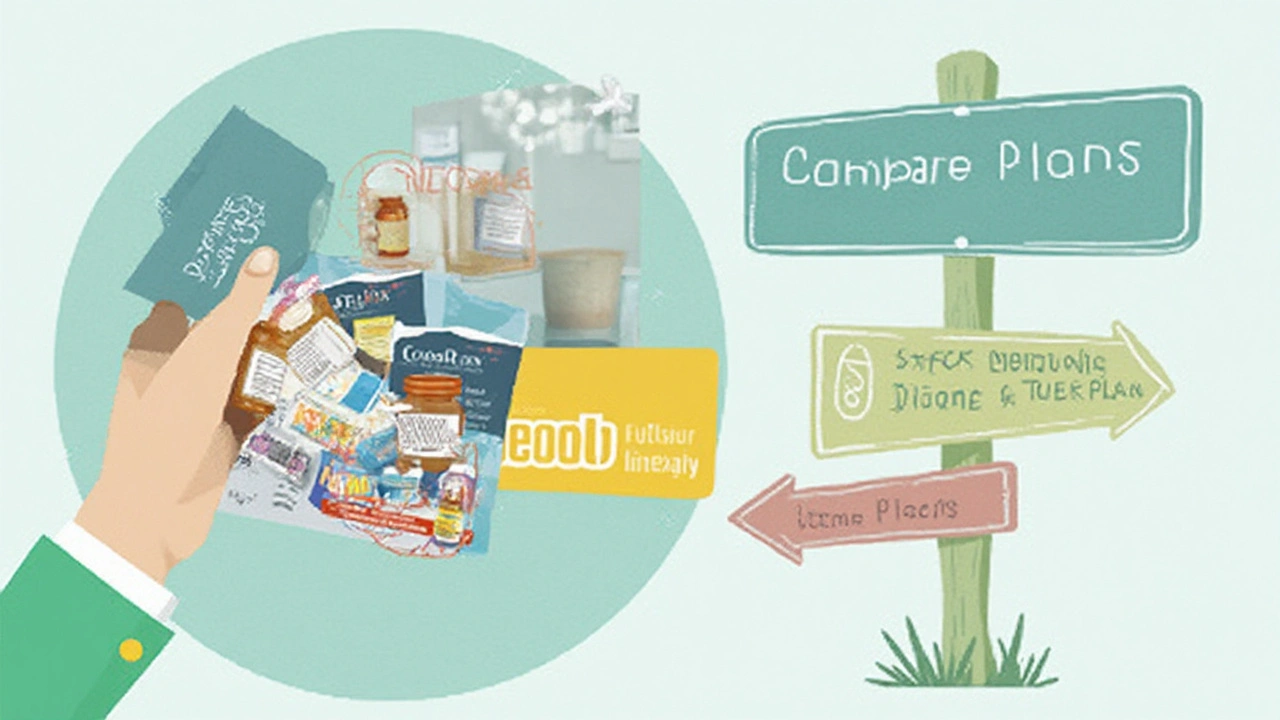Here’s something the ads won’t tell you: GoodRx might not always be your best bet on Medicare. Imagine standing at the pharmacy counter, clutching your brand-new Medicare card, only to find out the price with “America’s favorite discount card” barely budges—or worse, you’re told it can’t be used at all. Welcome to the not-so-small print of Medicare, where the right moves mean putting real money back in your wallet, and the wrong ones can leave you overpaying by hundreds every year.
Why GoodRx Doesn’t Always Cut It for Medicare Part D
If you thought GoodRx was the universal magic wand for slashing drug costs, you’re not alone. Their commercials are everywhere! But here’s the catch: If you’re enrolled in Medicare Part D, using GoodRx could leave you footing a bigger bill in the long run. Medicare rules say you can’t use manufacturer coupons with Part D, and while you technically can use pharmacy discount cards, like those that are similar to GoodRx, you’ll pay out-of-pocket—and those costs won’t count toward your deductible or out-of-pocket maximums. That small detail can make a big impact when your goal is hitting the “catastrophic coverage” zone, where costs drop dramatically for the year.
Let’s talk numbers. According to the Kaiser Family Foundation, the average annual out-of-pocket spending for Medicare Part D users not on Extra Help is around $600 for generic drugs but can soar over $3,000 for brand names. Using discount cards outside your Part D plan won't count toward that total. It’s like taking a shortcut that only leads you back to the start. And some pharmacies won’t let you stack GoodRx with Medicare coverage—or may even refuse to take GoodRx at all if you’re a Medicare customer.
This doesn’t mean discount programs are useless for Medicare folks. But knowing when and how to use them is key. Some savvy shoppers wait till they hit the infamous Coverage Gap (the “donut hole”), where their Part D copays skyrocket, and compare the cost with GoodRx and the plan’s rate. Sometimes, GoodRx (or a card like it) will save more during this period—especially for drugs not covered by your plan. But for most people, sticking to what your Part D plan covers usually wins out on price and counts toward your coverage milestones.
| Program Type | Counts Toward Part D Out-of-Pocket? | Accepts Discount Programs/Coupons? | Potential for Lower Price? |
|---|---|---|---|
| Medicare Part D | Yes | No | Often lowest for covered drugs |
| GoodRx or Similar Discount Cards | No | Yes (if cash pay, not Part D) | Sometimes for non-covered drugs or during donut hole |
| Manufacturer Coupons | No | No | Not valid with Part D |
So before swiping a coupon, always compare the pharmacy’s price using both your Medicare plan and GoodRx. Only go the discount route if it truly saves you money—and you’re okay with those payments not helping you reach catastrophic coverage.

Unlocking Extra Help: Little-Known Lifeline for Big Savings
Ready for a secret? There’s a program called “Extra Help” (or the Low-Income Subsidy) that can slash your Medicare Part D costs to the bone—often beating GoodRx and most other cards hands-down. Sadly, millions who qualify never apply.
If you’re a single person making less than $22,590 a year or a married couple under $30,660 (2025 limits), you might be eligible. Benefits include no Part D deductible, low or no premiums, and co-pays typically under $12. Sometimes, that means Brand Name drugs for less than even the fanciest coupon card. And—unlike GoodRx—the amounts you pay count toward out-of-pocket max, so you reach catastrophic protection faster.
Applying takes less time than it does to brew a cup of coffee. The Social Security Administration runs the process, and you usually only fill out a quick application, add in basic income/assets (your home, car, and life insurance don’t count), then wait. Seniors using Extra Help pay a fraction of what others pay. Even if you work part-time or have some savings, don’t rule yourself out. Check the SSA website or call your State Health Insurance Assistance Program (SHIP) for personalized help. SHIP counselors are real people, not sales reps. They can walk you through the forms for free.
Here’s the wild part: If you get any support from Medicaid, Supplemental Security Income (SSI), or certain state pharmacy programs, you may already qualify automatically. No paperwork headaches. Just check your mailbox for a yellow letter from Medicare or a “Notice of Award.”
Even a single missed application can cost you hundreds each year. The best hack? Every late summer, when Part D plans announce next year’s premiums, check Extra Help eligibility again. Your situation changes, their income limits change, and sometimes you sneak in for a year or two, banking major savings before you know it.
- Pro tip: If you lost Extra Help recently (like from a minor income bump), consider appealing or asking your SHIP counselor if there are 'partial' benefits available. Partial Extra Help still slashes your premiums and deductibles big-time.

Getting Creative: Hybrid Discount Plans and Comparison Shopping
If the phrase “plan comparison” makes your eyes glaze over, stick with me here—because this is where serious deal hunters start to win. The trick is learning how to combine Medicare coverage with outside savings programs, all while staying on the right side of the rules.
Start with Medicare’s own Plan Finder tool at Medicare.gov each fall during Open Enrollment. Plug in your full list of meds, doses, and preferred pharmacies. The tool shows which Part D plans cover your drugs, at what cost (including preferred versus standard pharmacy options), and your lowest total out-of-pocket tally for the year. Some folks flip plans annually to chase the best deals, and yes, it’s allowed.
If certain prescriptions aren’t covered—or if you get smacked by sky-high copays—a “hybrid” approach kicks in. Here’s how it works:
- Check GoodRx and similar sites for non-covered medications. If your needed drug isn’t on your plan’s formulary, buying it outside Part D at the cash price (using a discount card) might save you hundreds. This is popular for erectile dysfunction drugs, weight loss meds, and a few pricey generics.
- If you fill a drug using GoodRx (or a program like it), don’t try to mix it into your Part D plan’s claim. It won’t count toward deductibles or out-of-pocket spending, so use this only for one-off buys.
- For covered drugs, always use your Part D plan at the pharmacy register first. Double-check costs by calling your local pharmacy or using your carrier’s online portal.
If you’d rather let algorithms do the legwork, some websites now compare pharmacy, insurance, and discount card prices in one shot. Keep an eye out for these tools, but always make sure they apply to your Medicare situation. Links labeled similar to GoodRx often give you lists of new apps or programs, letting you see which card is really the cheapest today—not six months ago.
Pharmacies have their own discount programs too (think Walgreens Prescription Savings Club or CVS’s card). These aren’t Medicare, but sometimes beat even GoodRx or your Part D plan on select generics—worth checking for drugs not covered. Just remember: these club prices are cash buys and don’t count toward your Part D tally.
- Savvy Medicare pros often rotate their approach: use Part D for covered drugs, a discount card for uncovered meds, and occasionally sniff out one-off deals from independent pharmacies for pricey generics. It takes a little extra homework, but your wallet will thank you.
When you stack it all up, the biggest Medicare prescription savings come from the right blend of official coverage, smart apps or cards, and a willingness to shop around every year. That’s how you get a better deal than GoodRx—and make sure every dollar counts.





Darin Borisov
July 18, 2025 AT 14:22Concerning the labyrinthine intricacies inherent within the Medicare Part D plan architectures, one must undeniably appreciate the multifaceted nature of the cost-saving stratagems proposed here. While GoodRx, despite its ostensible ubiquity, remains but a superficial facade in the realm of pharmaceutical discounting for those on Medicare, the article eloquently elucidates the nuanced alternatives that merit scrupulous examination.
Indeed, the juxtaposition of Extra Help programs and hybrid discount plans presents a veritable cornucopia of opportunities for financial prudence. Yet, it is paramount that beneficiaries approach these options with a judicious discernment, fully cognizant of the regulatory parameters and legal ramifications attendant to stacking discounts.
Has the discourse adequately addressed the voluminous complexities of plan comparisons, especially those entailing formularies and tiered copays? One presumes an ecosphere wherein savvy navigation of these options could attenuate out-of-pocket expenditures significantly more than conventional wisdom suggests.
Sean Kemmis
July 21, 2025 AT 17:09Obviously, folks need to understand that GoodRx ain’t the golden ticket for Medicare holders. It's a fact that many don't want to admit or just overlook because it’s the 'brand name' that’s been shoved down their throats. This article is right to highlight the limits of GoodRx's utility here.
People should stop blindly trusting these flashy coupon systems when the government’s Extra Help program can potentially save them more. But no, ignorance reigns supreme, and most beneficiaries just settle for what’s easiest rather than what’s actually best.
Still, even with the alternatives, the bureaucratic mess makes it daunting to identify an optimal plan without losing your mind. Maybe it’s time to actually put the onus on Medicare to simplify this instead of forcing individuals to become expert bargain hunters. Just saying.
Nathan Squire
July 24, 2025 AT 19:42It’s curious how the American system, complex as it is, predicates savings on one’s ability to strategically navigate the labyrinthine Part D policies. I found the commentary on hybrid discount plans particularly fascinating — a mechanism that, when employed ethically, can indeed optimize benefit realization.
However, I can’t help but detect a subtle irony: the very frameworks designed to aid Medicare beneficiaries impose such cognitive strain that only a select few can exploit them effectively. This induces an unintended moral dilemma — is the labyrinth too intricate intentionally, to privilege the savvy and disenfranchise the less informed?
Nonetheless, the article’s practical suggestions for comparison and stacking discounts reflect a commendable attempt to level the playing field, albeit a complex one. Any further illumination on the ethical boundaries of discount stacking would be appreciated.
satish kumar
July 27, 2025 AT 19:29Let's be honest; no system is perfect, and the Medicare Part D landscape is littered with convoluted clauses and caveats that make it anything but user-friendly! The notion that GoodRx is the ultimate solution is frankly laughable, and this article rightly calls that into question with a barrage of alternatives.
The whole question around combining discounts legally is exhausting. How many people out there actually have the time or the patience to cross-check every last detail and regulatory tidbit? It’s like being trapped in an endless loop of paperwork and approval hoops.
Still, I guess it's better than just paying full price without even a glance at what could be saved. Maybe some sort of centralized digital tool with real-time price comparisons could save everyone a headache?
Matthew Marshall
July 30, 2025 AT 19:16Wow, reading all this just reminds me how messed up the whole prescription pricing system is. It’s nuts that we even have to game the system like this to afford life-saving meds. The fact that GoodRx isn’t really a meal ticket for Medicare folks feels like a slap in the face, honestly.
Maybe it’s just me, but I kinda feel like all these 'savvy alternatives' discussed are just putting more responsibility on the patient when maybe the whole system should just be simpler and cheaper. Drama aside, can anyone really keep track of all these plans and discounts without losing it?
Anyway, I guess it’s good info, but it’s a bit overwhelming. Makes me appreciate how much luckier some parts of the world are with their healthcare.
John Moore
August 2, 2025 AT 19:02Thank you for posting this detailed dive into prescription savings for Medicare recipients. I think many people underestimate how layered Part D plan options really are. It’s critical that beneficiaries become proactive in comparing plans annually since drug formularies and pricing can shift substantially.
I appreciate the article’s emphasis on leveraging Extra Help and hybrid discount plans. These are tools that aren’t widely known yet can make a genuine financial difference. Educating others about these possibilities is a great step toward reducing medication burdens.
Has anyone here successfully combined multiple discount avenues to reduce their costs? Hearing real-world experiences with stacking could shed light on practical constraints and benefits.
Adam Craddock
August 5, 2025 AT 18:49I’m intrigued by the mention of legal stacking of discounts—this area invites critical scrutiny. Are all insurance providers on board with such maneuvers, or could beneficiaries face penalties or denials if they inadvertently cross lines?
Exploring the regulatory nuances could provide reassurance to those hesitant to utilize multiple savings methods. A formalized framework that clarifies permissible stacking would be invaluable for widespread adoption.
Additionally, how often do these savings genuinely translate into lower copays versus shifting costs elsewhere in the system? Transparency is key to assess the true value of such strategies.
Kimberly Dierkhising
August 8, 2025 AT 18:36This article offers a comprehensive synthesis of the jargon-heavy Medicare prescription savings landscape. It's enlightening to see the confluence of federal programs like Extra Help working in tandem with private sector hybrid discount solutions.
However, such multifactorial approaches demand beneficiaries not only comprehend intricate formularies but also skillfully navigate pricing algorithms and plan variations. Empowerment through education seems paramount here.
Moreover, one should be vigilant regarding the implications of discount stacking on plan eligibility and future benefits. The balancing act between legality and optimization requires nuanced counsel.
Does anyone have recommendations for reliable sources or advisors specializing specifically in this prescription cost arena?
Rich Martin
August 11, 2025 AT 18:22I just can’t stand how convoluted the whole Medicare prescription setup is. It’s like they purposely design it so no average joe can get what they deserve.
When it comes to GoodRx, yeah it’s popular but for Medicare it’s often useless. The article’s point about hybrid discount and Extra Help is solid, but come on, the hoops people have to jump through to get those are insane.
I'm kinda tired of having these debates while the prices keep skyrocketing. Where’s the outrage? Anyway, if anyone knows a way to cut through this mess and get decent prices without losing your mind, I’m all ears.
Buddy Sloan
August 14, 2025 AT 18:09Wow, this is truly eye-opening! 😊 It's great to know there are smarter ways to save on meds beyond the usual GoodRx stuff.
From what I gather, understanding Medicare Part D and Extra Help programs can really make a big difference in costs. It seems like stacking discounts legally could be a gamechanger, but I’d love to hear more examples of how that works in practice.
Thanks for sharing this valuable info! I’m definitely going to dig deeper and maybe help some family members who pay way too much for prescriptions. :)
SHIVA DALAI
August 17, 2025 AT 17:09The formal delineation of the limitations inherent in GoodRx when interfaced with Medicare is most insightful. It is undeniable that beneficiaries must be apprised of the complexities and subtleties of Part D and the Extra Help framework to optimize their pharmaceutical expenditures effectively.
However, it behooves us to recognize that navigating these programs necessitates a degree of sophistication and familiarity with healthcare policy that may exceed the capacity of many elderly recipients.
Hence, a more structured and accessible advisory system tailored to the demographics in question would significantly enhance outcomes and reduce financial strain.